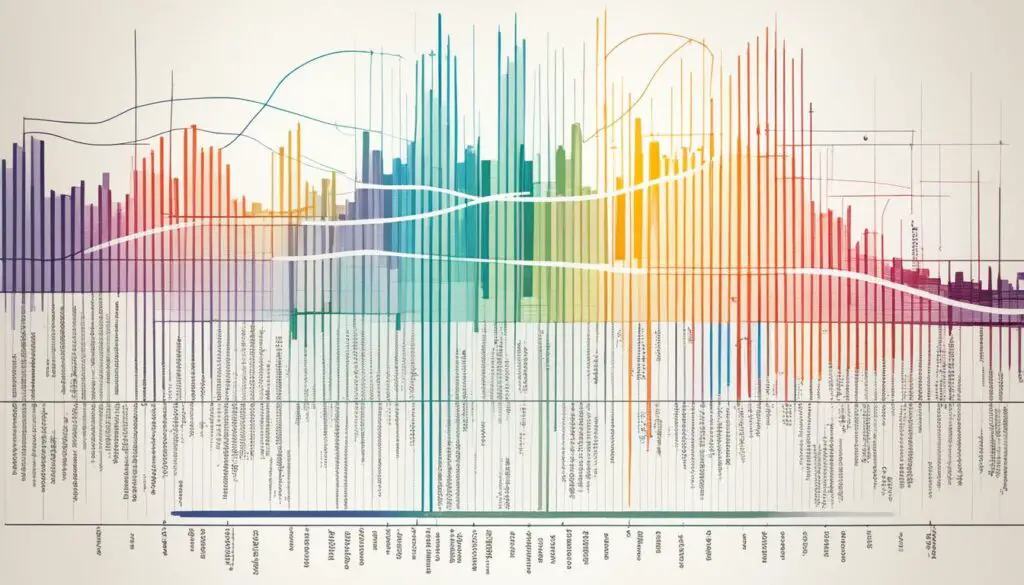Gain Deeper Insights with Multivariate Analysis in Bible Study
I find myself diving deep into Bible study, always looking for a better way to understand the text. I’ve used traditional methods, which have been helpful. But I wanted to go further. Then, I came across the method of multivariate analysis.
Multivariate analysis is a technique for examining many aspects and how they relate to each other. It helps to reveal hidden connections and patterns. These are things we might miss with usual study methods. Doing this with Bible translations lets us look into the text’s details and complexities like never before.

Key Takeaways:
- Multivariate analysis enhances understanding of Bible translations.
- It uncovers hidden patterns and correlations that traditional study methods may miss.
- Through multivariate analysis, we gain insights into the nuances and complexities of the text.
- Implementing multivariate analysis requires a comprehensive dataset and statistical software.
- Integrating multivariate analysis into Bible study practices enhances our engagement with the scriptures.
The Benefits of Multivariate Analysis in Bible Study
Multivariate analysis brings great benefits to Bible study. It helps us understand and interpret the scriptures better. This tool lets us discover hidden insights and appreciate the complexity of various Bible versions.
- A holistic approach: It lets us look at many factors together. This includes things like writing style, the culture of the time, and the meaning behind the text. It gives us a deeper perspective into the translations and their true message.
- Revealing complex relationships: With multivariate analysis, we find how different parts of the text connect. We can see how the writing style reflects its cultural background, or how theological ideas interact. This method helps us understand the text’s depth and complexity better.
- Enhanced interpretation: Multivariate analysis aids in making better sense of the text. By looking at various elements, we can understand why translations differ. It leads to a richer understanding of the text, helping us to interpret it more accurately.
Using multivariate analysis, our understanding of the Bible deepens. We can relate to the text on a profound level.
Consider comparing two Bible translations through multivariate analysis. One may focus on historical accuracy, while the other on being easy to understand. This helps us see why variations exist, impacting the message’s delivery and meaning.

Exploring the Benefits: An Example Comparison
| Translation | Language Style | Cultural Context |
|---|---|---|
| NIV | Contemporary | Global |
| KJV | Traditional | Historical |
This table compares two Bible translations based on language and context. Multivariate analysis shows us how these aspects work together. For instance, the NIV reaches a wide audience with its modern style, while the KJV stays traditional with a focus on history.
Using multivariate analysis enriches our Bible study. It reveals deeper meanings in the text. This approach helps us understand different translations better and connects us further with God’s Word.
Implementing Multivariate Analysis in Bible Study
To use multivariate analysis in Bible study, we need a rich dataset. This should cover many translations and key analysis variables. Our dataset might include languages, cultural elements, history, and theological themes. By blending these diverse aspects, we aim for a complete view of various translations and their contexts.
After assembling our dataset, the next step is to crunch the numbers. We can do this with statistical software. This process includes cluster, factor, and regression analyses. These tools reveal hidden links, patterns, and deep data insights. They help us understand Bible translation similarities and differences.
Integrating these advanced analyses enhances our Bible study experience. It helps us grasp the text’s details and its abundant meaning. We move beyond the surface, gaining profound insights. This approach leads to a more enlightening and significant interaction with the Bible.
FAQ
What is multivariate analysis and how does it relate to Bible study?
What are the benefits of using multivariate analysis in Bible study?
How can I implement multivariate analysis in Bible study?
What insights can multivariate analysis provide in Bible study?
Source Links
- https://www.ecsi.site/uploads/file/bibliography/krysinska-k-et-al-measuring-religious-attitudes-in-(post-)secularised-western-european-context-(2014).pdf
- https://digitalcommons.liberty.edu/cgi/viewcontent.cgi?article=5836&context=doctoral
- http://experimentaltheology.blogspot.com/2010/09/theology-of-type-1-type-2-errors.html
